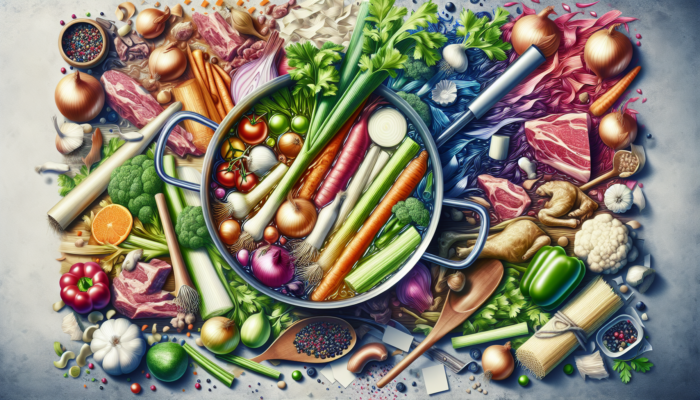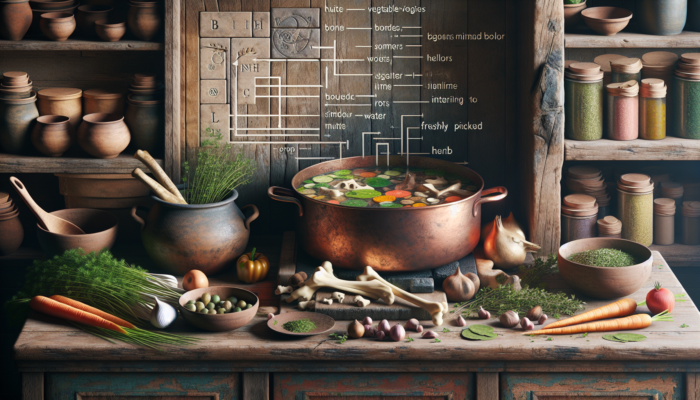Discover How to Create Delicious Homemade Stock Using Kitchen Scraps
Acquiring the skill to craft your very own homemade stock is not only a crucial culinary technique but also an essential step towards a more sustainable cooking practice. By mastering the art of making stock from scraps, you can significantly enhance the flavour of your dishes while simultaneously reducing food waste. This method not only benefits your culinary creations but also contributes positively to the environment. Join us as we explore the fundamental aspects that will guide you on a fulfilling journey in producing flavoursome stock.
Why Fresh Kitchen Scraps are Essential for High-Quality Stock

The quality of your stock largely depends on the freshness of the ingredients you use. Incorporating fresh scraps can yield a stock that is not only robust in flavour but also serves as a perfect base for a variety of dishes, spanning from hearty soups to exquisite sauces. Fresh vegetable scraps such as onion skins, carrot tops, and celery leaves infuse vibrant flavours and essential nutrients into your stock. Additionally, fresh meat scraps, including bones and trimmings, impart a richer, more intricate flavour profile. Always opt for fresh produce and meats, as spoiled or wilted ingredients can adversely affect both the taste and safety of your stock.
Essential Ingredients for Creating Exceptional Stock
As you embark on your stock-making adventure, it’s vital to keep your ingredient list simple yet effective. The key ingredients include water, a variety of vegetables, and meat scraps. Water serves as the primary medium, extracting the rich flavours from your scraps. For vegetables, consider incorporating commonly discarded items such as onion skins, carrot peels, and garlic cloves. If you are preparing a meat stock, bones and trimmings from chicken, beef, or other meats are crucial for building a deep flavour base. Additionally, incorporating herbs like parsley, thyme, or bay leaves can greatly enhance the aromatic qualities and overall taste of your stock, making it even more delightful.
Optimising Cooking Time and Temperature for Perfect Stock
One of the most critical aspects of creating stock lies in the careful management of both cooking time and temperature. It is essential to allow your stock to simmer gently for a minimum of 2 hours on low heat. This slow cooking process allows flavours to meld harmoniously while extracting the maximum amount of nutrients from your scraps. Overheating may lead to a bitter taste and an unappealing cloudiness, so it’s crucial to maintain a low temperature and a gentle simmer throughout the cooking duration. For meat-based stocks, consider extending the simmering time to at least 4 hours or more, especially when utilising larger bones, to ensure that every ounce of flavour is captured.
Your Ultimate Step-by-Step Guide to Crafting Homemade Stock from Kitchen Scraps

Creating stock from scraps is a straightforward process that anyone can master with ease. Follow this comprehensive step-by-step guide to ensure that your stock is bursting with flavour and nutrients.
Efficiently Collecting and Storing Your Kitchen Scraps
Begin by accumulating a variety of vegetable and meat scraps over time. Designate a specific container in your refrigerator or freezer to store these valuable scraps. This container can hold items such as onion peels, carrot tops, celery leaves, and any meat trimmings you might have. The beauty of this method is that you can gradually build up a collection of scraps, making the process of stock-making both convenient and environmentally friendly. Aim to gather enough scraps to fill a large pot when you are ready to make your stock, ensuring that you are prepared for the cooking process.
Preparing Your Pot for Successful Stock Creation
Once you have collected your scraps, the next step is to prepare your pot. Choose a large pot that can comfortably accommodate all your scraps and water without the risk of overflowing. A stockpot is ideal, but any large pot will suffice. Add your vegetable and meat scraps into the pot, ensuring a balanced mix for optimal flavour extraction. Fill the pot with cold water, covering the scraps by approximately an inch. Starting with cold water aids in the efficient extraction of flavours during the cooking process, resulting in a richer final product.
Simmering Your Stock for Maximum Flavour Infusion

Place your pot on the stove and bring it to a gentle boil. Once boiling, reduce the heat to low to maintain a gentle simmer, which is a crucial phase in the stock-making process. Allow it to simmer for at least 2 hours, stirring occasionally to prevent the scraps from sticking to the bottom. For meat stocks, consider extending the simmering time to 4 hours or longer. As the stock simmers, you will notice it transforming into a lovely golden hue, while a rich aroma fills your kitchen. This slow simmering process allows the flavours to meld beautifully, resulting in a nutritious and delicious base for your culinary creations.
Straining Your Stock for Clarity and Enhanced Taste
Once the simmering process is complete, it’s time to strain your stock. Carefully remove the pot from the heat and allow it to cool slightly. Using a fine mesh strainer or a cheesecloth, strain the stock into another pot or bowl, discarding the solids. This essential step is vital for achieving clarity and a refined flavour in your stock. If you desire an even clearer stock, consider straining it multiple times. Once strained, allow the stock to cool completely before storing it in the refrigerator or freezer to preserve its freshness and taste.
Explore the Advantages of Using Kitchen Scraps for Homemade Stock
Creating stock from scraps is not merely a sustainable cooking practice; it provides a multitude of benefits that make it a wise choice for any home cook eager to enhance their culinary skills.
Save Money While Minimising Food Waste
Utilising scraps significantly lowers food waste while saving you money. Instead of purchasing pre-made stock or broth, you can create your own using ingredients that would otherwise be discarded. This economical approach is particularly advantageous for those on a budget or anyone striving to be more mindful of their grocery spending. By repurposing scraps, you ensure that every part of your food contributes to a delightful meal, making your cooking practices more cost-effective and resource-efficient.
Enhance the Nutritional Value of Your Meals with Homemade Stock
Another significant advantage of crafting stock from scraps is the increased nutritional value it brings to your dishes. Vegetable scraps often contain vitamins and minerals that can boost the health benefits of your stock. For example, carrot tops are rich in vitamin C and dietary fibre, while onion skins provide antioxidants. Furthermore, meat scraps, particularly bones, are abundant in collagen, which is beneficial for joint health. Consequently, the stock you create not only amplifies flavour but also serves as a nourishing enhancer in your meals.
Make a Positive Environmental Impact Through Sustainable Practices
Utilising scraps for homemade stock significantly contributes to reducing landfill waste, making it an environmentally responsible choice. By maximising the use of your food, you contribute to a more sustainable kitchen while decreasing your overall carbon footprint. This practice nurtures a mindset of resourcefulness and sustainability that extends beyond the kitchen. By sharing your stock-making journey with others, you can inspire a collective movement towards reducing food waste in your community, promoting sustainable cooking practices that benefit everyone involved.
Selecting the Best Types of Scraps for Flavourful Stock
Choosing the right scraps is vital in crafting a delicious and aromatic stock. Here’s a detailed guide on the best types of scraps to utilise for optimal flavour extraction.
Boost Flavour with Quality Vegetable Scraps
Vegetable scraps form the backbone of a flavoursome stock. Ingredients such as onion skins, carrot tops, garlic cloves, and celery leaves are among the most effective options to consider. These components add depth and sweetness to your stock, resulting in a robust base for soups and sauces. Additionally, you can incorporate herbs like parsley stems, thyme, and bay leaves to infuse your stock with aromatic qualities. Experimenting with various combinations allows you to discover your preferred flavour profile, ensuring that your stock is both unique and delicious.
Achieving Richness with Quality Meat Scraps
If you aim to produce a rich meat stock, incorporating bones and meat trimmings is essential. Chicken carcasses, beef bones, and pork scraps work wonderfully, delivering a depth of flavour that vegetable scraps alone cannot provide. Roasting the bones prior to adding them to your stock can intensify their flavour, imparting a caramelized note to your final product. The collagen released from the bones during the simmering process adds both body and richness to your stock, making it an indispensable element for hearty soups and stews.
Elevate Taste with Herb Scraps
Herb scraps, though frequently overlooked, can elevate your stock to new heights. Stems from fresh herbs like parsley, cilantro, and thyme add a fragrant aroma that enhances the overall taste of your stock. You can also experiment with more robust herbs like rosemary or sage to impart a distinct character to your stock. Remember, balancing the flavours is crucial; use herb scraps judiciously to avoid overpowering the other ingredients.
Smart Strategies for Storing and Freezing Your Homemade Stock
After successfully creating your stock, proper storage is essential for preserving its freshness and flavour. Here are some effective strategies for storing and freezing your homemade stock.
Rapid Cooling Techniques for Stock Safety
Before storing your stock, it’s critical to cool it quickly to prevent bacterial growth. Divide the hot stock into smaller portions in shallow containers to facilitate faster cooling. Additionally, consider placing the containers in an ice bath to expedite the cooling process. Once the stock reaches room temperature, transfer it to the fridge if you plan to use it within a few days, or proceed to freeze it for long-term storage.
Freezing Stock in Convenient, Usable Portions
Freezing your stock in manageable portions is an excellent way to ensure you have it readily available for future use. Ice cube trays are perfect for this purpose; simply pour the cooled stock into the trays, freeze, and then transfer the cubes to a freezer bag. This method allows you to defrost only the amount you require for your recipes, significantly reducing waste and ensuring that your stock maintains its quality over time.
Labeling and Dating Frozen Stock for Freshness
Always label and date your frozen stock to keep track of its freshness. This simple yet effective step can save you from the disappointment of discovering that your stock has been in the freezer too long. Typically, homemade stock can be stored in the freezer for up to six months. After this period, the flavour may diminish, so keep an eye on your inventory and utilise it within this timeframe for the best results.
Avoiding Common Mistakes When Making Stock
While making stock is a relatively straightforward process, there are common errors that can lead to unsatisfactory results. Avoiding these pitfalls will ensure that your stock is both delicious and nutritious.
The Risks of Overcooking Your Stock
One of the most common mistakes people make is overcooking the stock. While it might seem logical that a longer cooking time would yield a more flavourful stock, overcooking can result in a bitter taste. Aim for a gentle simmer, carefully monitoring the cooking time. For vegetable stock, 2 to 3 hours is sufficient, while meat stocks may require 4 hours or longer. Trust the process and avoid rushing to achieve the best flavour possible.
Ensuring Freshness: Avoid Spoiled Scraps
Another crucial error is using spoiled scraps, which can ruin the flavour of your stock and pose potential safety risks. Always inspect your vegetable and meat scraps before adding them to the pot. If any scraps show signs of spoilage, it’s best to discard them rather than risk compromising the quality of your stock. Freshness is vital, so be diligent in selecting your ingredients to guarantee a safe and tasty outcome.
The Necessity of Skimming Impurities from Your Stock
Neglecting to skim off impurities during the cooking process can result in a cloudy stock. As the stock simmers, various impurities will rise to the surface. Use a ladle or skimmer to remove these impurities, achieving a clearer and more refined stock. This step not only improves the appearance but also enhances the taste, making your stock more visually appealing and palatable.
Innovative Culinary Uses for Your Homemade Stock
Once you’ve mastered the art of creating stock from scraps, the next step is to creatively incorporate it into your recipes. Here are some inspiring ideas to elevate your culinary creations.
Crafting Delectable Hearty Soups and Stews
Homemade stock serves as an exceptional foundation for hearty soups and stews. Whether you’re preparing a classic chicken soup or a robust beef stew, using your stock adds a depth of flavour that store-bought options simply cannot replicate. Experiment with various ingredients and spices to create dishes that reflect your unique tastes and culinary flair.
Enhancing Sauces and Gravies Using Homemade Stock
Elevate your sauces and gravies by incorporating the rich flavour of homemade stock. Whether you’re making a simple pan sauce or a complex gravy for a roast, substituting stock for water or store-bought broth will elevate your dish to new culinary heights. The depth of flavour in your stock will shine through, making your sauces more robust and delicious, providing a delightful experience for your diners.
Infusing Flavour into Risotto and Rice Dishes with Stock
Using stock as the cooking liquid for risotto or rice dishes imparts incredible depth of flavour. Instead of plain water, replace it with your homemade stock for a richer and more satisfying meal. The stock will infuse the grains with its flavour, ensuring that each bite is a delight. This technique works beautifully for any rice dish, from pilafs to paellas, enhancing the overall dining experience.
Utilising Stock for Braising Meats to Achieve Optimal Tenderness
Homemade stock is perfect for braising meats, providing both flavour and moisture for a tender result. Whether you’re braising beef, pork, or chicken, using your stock as the braising liquid ensures that the meat absorbs all the delicious flavours. The result is a succulent dish that showcases the effort you invested in making your stock, impressing everyone at your table.
Understanding the Environmental Benefits of Using Kitchen Scraps for Stock
Creating stock from scraps is not only a practical cooking method but also brings substantial environmental advantages. Here’s how your kitchen efforts can positively impact the planet.
Significantly Reducing Food Waste
By making stock from scraps, you actively contribute to the reduction of food waste. Each year, an astonishing amount of food is discarded, leading to overflowing landfills and greenhouse gas emissions. By repurposing scraps that would otherwise go to waste, you’re making a conscious choice to lessen your environmental impact while making the most of your resources.
Lowering Your Overall Carbon Footprint
Every bit of food waste that ends up in a landfill contributes to your carbon footprint. By utilising scraps for homemade stock, you help reduce your carbon emissions. The more we can do to cut down on waste, the smaller our overall environmental impact becomes. This small change in your cooking habits can lead to significant improvements in sustainability, making a meaningful difference.
Encouraging Sustainable Cooking Practices in Your Community
Sharing your knowledge about making stock from scraps can inspire others to adopt sustainable cooking practices. By demonstrating how easy and beneficial it is to repurpose kitchen scraps, you foster a culture of mindfulness surrounding food consumption. This ripple effect can lead to broader community initiatives focused on reducing food waste and promoting sustainability, creating a more responsible approach to cooking.
Building Community Connections Through Sustainable Cooking Efforts
Finally, discussing your stock-making tips and experiences within your community can cultivate a sense of shared responsibility towards sustainability. Encouraging neighbours and friends to adopt similar practices can form a supportive network aimed at reducing waste and embracing sustainable cooking. This collective effort can result in a more environmentally conscious community, benefiting everyone involved and fostering a culture of sustainability.
Frequently Asked Questions (FAQs)
Are all vegetable scraps suitable for stock?
You can use a variety of vegetable scraps, but focus on flavourful options like onion skins, carrot tops, and celery leaves. Avoid using bitter vegetables or those that spoil quickly, as they can negatively affect your stock's taste.
How long can homemade stock be safely stored in the fridge?
Homemade stock can typically be stored in the fridge for up to 3-4 days. If you don’t plan to use it within that timeframe, freezing is recommended for longer-term preservation.
Is it safe to use meat scraps for stock-making?
Absolutely! Using fresh meat scraps, bones, and trimmings is safe and adds richness to your stock. Ensure they are fresh and properly handled to avoid any food safety issues.
Can I create stock without using meat?
Definitely! Vegetable stock can be just as flavourful and nutritious as meat stock. Focus on utilising a variety of vegetables and herbs to create a depth of flavour that will satisfy your palate.
What’s the best method to thaw frozen stock?
The best way to thaw frozen stock is to transfer it to the fridge the night before you intend to use it. You can also thaw it in a microwave or by placing the container in warm water, ensuring it’s ready for your cooking requirements.
Can I reuse scraps for making stock?
While you can reuse some vegetable scraps, they may lose flavour after the first batch. It’s best to use fresh scraps for optimal results in subsequent batches to maintain the quality and taste of your stock.
How can I tell if my stock has gone bad?
If your stock develops an off smell, unusual colour, or any signs of mould, it’s best to discard it. Always trust your senses to ensure food safety and quality.
Is it okay to add spices during the stock cooking process?
Yes! Adding spices like peppercorns, bay leaves, and herbs while cooking can enhance the flavour profile of your stock. Just remember to strain them out before storing to maintain a clear stock.
Is homemade stock more nutritious than store-bought options?
Homemade stock often contains higher nutrients and flavour compared to store-bought varieties, as you control the ingredients and can include nutrient-rich scraps that enhance the final product.
Can stock be made in a slow cooker?
Yes, making stock in a slow cooker is an excellent option. Simply add your scraps and water, set it on low, and let it simmer for several hours for a rich and flavourful stock.
Connect with us on Facebook!
The post Homemade Stock: Easy Guide Using Kitchen Scraps appeared first on https://cookinggods.com
The Article Easy Guide to Homemade Stock from Kitchen Scraps Was Found On https://limitsofstrategy.com


Your insights on creating homemade stock from kitchen scraps resonate deeply with my culinary journey. I’ve been on a quest to adopt more sustainable cooking habits, and making stock is a delightful way to involve myself in the process while minimizing waste. It’s really astonishing to think about how much we often discard without realizing their potential to enhance our meals.
It’s great to hear about your culinary journey and focus on sustainable cooking. I totally agree—making stock from kitchen scraps not only reduces waste but also elevates the flavors in our meals. I’ve found that even the most unassuming vegetable peels or herb stems can lend such depth to a broth.
You’ve captured something really important about cooking with intention and maximizing every part of the ingredients we buy. It’s interesting how the kitchen scraps often hold the potential for flavor that we might overlook. I’ve found that those seemingly trivial bits—like the tough stems of herbs or the ends of onions—can transform a simple pot of stock into something quite remarkable.
It’s great to hear that you’re on this journey toward sustainable cooking. Homemade stock truly embodies the essence of resourcefulness. It’s incredible how something as simple as vegetable peels, herb stems, or even a leftover chicken carcass can transform into a rich, flavorful base for so many dishes.
I completely agree; homemade stock really is a testament to how we can make the most of what we have. It’s fascinating how something that might otherwise go to waste can become the foundation of a delicious meal. I often find that making stock not only adds depth to my cooking but also makes me feel more connected to the ingredients themselves.
I completely agree with your thoughts on homemade stock. There’s something satisfying about transforming scraps into something nourishing and flavorful. I find that it really changes the way I view cooking as a whole—less about following a recipe to the letter and more about seeing what ingredients are available and how they can come together.
It’s nice to connect over this journey toward sustainable cooking. I find it fascinating how homemade stock not only reduces waste but also adds so much depth to the flavors in our meals. Recently, I started keeping a “stock bag” in the freezer where I toss in vegetable scraps, herb trimmings, and meat bones as I cook throughout the week. I love how it becomes a little treasure trove of flavors, each ingredient telling a story from previous meals.
It’s great to hear about your stock bag approach; it really embodies the spirit of sustainable cooking. I’ve found that incorporating food scraps into my cooking not only minimizes waste but also encourages creativity in the kitchen. It’s like the ingredients are having a conversation, each adding its unique flair.
I completely relate to your approach; it made me think of this delightful recipe I recently discovered, showcasing how homemade stock can elevate the flavors in a comforting soup.
‘Mexican Tortilla Soup: Hearty Homemade Delight’
https://bonnieaffair.co.uk/mexican-tortilla-soup-hearty-homemade-delight/.
It’s refreshing to hear your thoughts on the stock bag approach and how it opens up avenues for creativity in the kitchen. The idea of food scraps engaging in a conversation captures the essence of cooking from a place of resourcefulness and imagination—a perspective that’s often overlooked in our fast-paced culinary culture.
I’m so glad to hear that you’re enjoying the creativity that comes with using food scraps! Your mention of the Mexican Tortilla Soup sounds fantastic—it’s a perfect way to showcase the depth of flavor that homemade stock can bring. If you’d like to explore that delightful recipe further, check it out here!
https://bonnieaffair.co.uk/quillbot
I love how you describe the ingredients having a conversation—it’s so true! Each time I pull out my stock bag, it feels like I’m curating a little symphony of flavors, each contributing to something greater.
It’s great to hear how you’re embracing this practice of keeping a “stock bag.” The idea of using scraps and trimmings really taps into the essence of sustainable cooking. Each ingredient indeed carries the memory of past meals, transforming simple leftovers into something rich and complex.
I’m so glad to hear you’re embracing sustainable cooking! If you’re interested in learning more about maximizing flavor and minimizing waste, check out this guide on making the most of your stock bag.
https://bonnieaffair.co.uk/krystal
I really resonate with what you’ve shared about keeping a stock bag. There’s something special about using what we might consider “leftovers” to create something rich and flavorful. It’s like a sustainable way to honor the food we’ve enjoyed while coaxing out the fullest expression of taste.
It’s great to hear about your stock bag—such a practical way to make the most of what you have. That idea of it being a “treasure trove of flavors” really resonates. Each scrap has the potential to elevate your next dish, turning what might otherwise be waste into something vibrant and full of life.
It’s great to hear you’re on that journey toward more sustainable cooking. Making stock from kitchen scraps really transforms the way we think about what we throw away. Carrot tops, onion skins, or even those slightly wilted herbs can add so much depth to a dish. I used to toss them without a second thought until I realized they can be the backbone of a flavorful broth.
You’ve hit on something so fundamental in cooking. It’s wild to think that so many of us just discard those bits without a second thought. I’ve had my own moments where I’ve been amazed by how much flavor can come from the neglected parts of a vegetable. Carrot tops can be used in pestos, or if you roast beets, those greens are just begging to be sautéed.
I’m glad to hear you’re on that journey too! It’s amazing how something as simple as kitchen scraps can shift our perspective on what’s useful in cooking. Carrot tops and onion skins are often overlooked, yet they bring so much character to a broth. I’ve started experimenting with different leftover vegetables, and it’s surprising how each combination can yield a unique flavor.
“I’m glad to hear you’re embracing a sustainable approach! If you’re looking for more tips on utilizing kitchen scraps and reducing waste, check out this helpful guide.”
https://bonnieaffair.co.uk/quillbot
I’m glad to hear that the journey toward sustainable cooking resonates with you. Turning kitchen scraps into something as versatile as stock is not just about minimizing waste; it’s also a way to draw out all those hidden flavors you might typically overlook. I used to be surprised at how much life is left in vegetable peels, herb stems, and even the ends of onions. It’s like unlocking a secret ingredient in your kitchen.
It’s great to hear that you’re on this journey toward more sustainable cooking habits. The idea of making stock from kitchen scraps is not only resourceful but also connects us with the food we consume in a more meaningful way. I’ve found that each batch of stock can have its own unique flavor depending on what I’ve thrown in—things like onion skins, carrot tops, and even herb stems can bring out new tastes that you might not expect.
It’s great to hear that you’re on a journey towards more sustainable cooking habits. Making stock from kitchen scraps really feels like a form of alchemy, doesn’t it? I’ve found it not just a way to minimize waste, but also a therapeutic process. Sitting down with a handful of vegetable peels, herbs, and leftover bones can feel almost meditative as I think about how these scraps come together to create something nourishing.